Surfski.info Review: Allwave CX
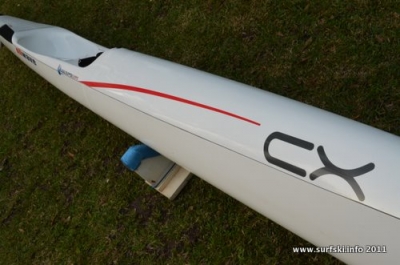 The Allwave CX
Credits: www.surfski.info
The Allwave CX
Credits: www.surfski.info
When Mario Graziani called to say that there was an Allwave CX surfski in Cape Town and would I like to try it, I leapt at the chance. At the same time I was a little apprehensive – what could Italians possibly know about making surfskis?!
(Trying out a new ski is sometimes a little hairy. I tried a prototype once on a big downwind – the ski was a total lemon and had terrible drainage. The cockpit filled with water and the ski became almost uncontrollable. In the words of a Spanish friend, “I fear for my life”!)
First Looks
This is a very good-looking ski. The boat that I paddled had been made in Italy at the Allwave factory there and, judging by the seams, they have build techniques that are more precise than most manufacturers. Every other ski that I’ve ever seen has a thick layer of resin over the seam – which disguises any imperfections in the mating of the deck with the hull. Not the CX.

For a bigger image, click here

For a bigger image, click here

For a bigger image, click here
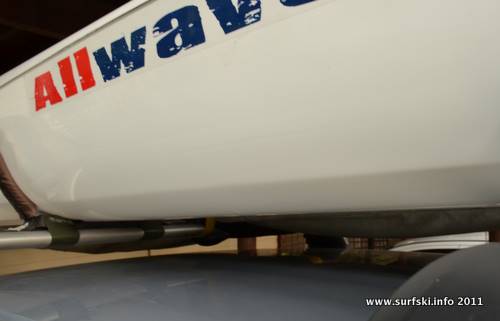
The CX has quite pronounced "hard chine" - and the precision of the build is shown by that unhidden seam
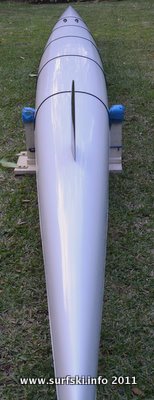

Deep-V up front; broad and flatter behind
The fittings too are precise and beautifully engineered. Apart from their experience with outrigger canoes, the company also has long experience of building yachts, and this is evident in controls that adjust not only the footplate but also the angle of the rudder pedals. The tiller bar too is a beautiful machined stainless steel part – a far cry from the roughly stamped, bent and filed apologies for a bar that I’ve seen in some other skis!
Footplate Adjustment
A line with a plastic handle is placed conveniently near your right hand. Pull the handle and the footplate locks are released. The first time I paddled the ski I set up the footplate too short. By pulling the handle and pushing the footplate with my heels, I was able to reset the leg length in seconds.
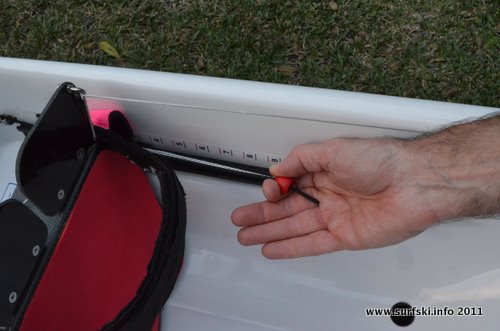
Pull on the bobble to release the footplate locks
The footplate is longer than other skis I’ve paddled, leaving you to steer with your toes. This took a little time to get used to, but given the lightness of the steering (as a result of the balanced rudder) I found that I enjoyed being able to push with my whole foot on the plate.
Pedal angle adjustment
The rudder lines, after passing through the rudder pedals, are combined to a single rope running through a cleat mounted on the front bulkhead of the cockpit. Again – this is very easy to adjust: pull the line tighter to tilt the pedals back; looser to tilt them forward.
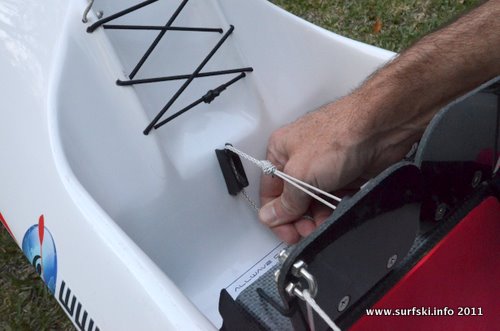
Adjusting the pedal angle
Ease of adjustment v Simplicity
Some of the folks who have seen the boat questioned whether the pedal angle adjustment was really necessary. “Won’t that slip eventually?” was one comment. All I can say is that in the month that I had the boat, it didn’t slip at all.
Some other skis use a simple knot for this purpose (the lines run around the front of the cockpit and are tied together); some require each line to be adjusted in turn. It was certainly convenient though to be able to adjust the pedal angle so easily (following the example of Oscar Chalupsky I’ve formed the habit of setting my pedals much flatter then I used to. I used to have them tilted slightly towards me; now I set them almost tilting away from me – which reduces the amount of inadvertent steering as you paddle.)
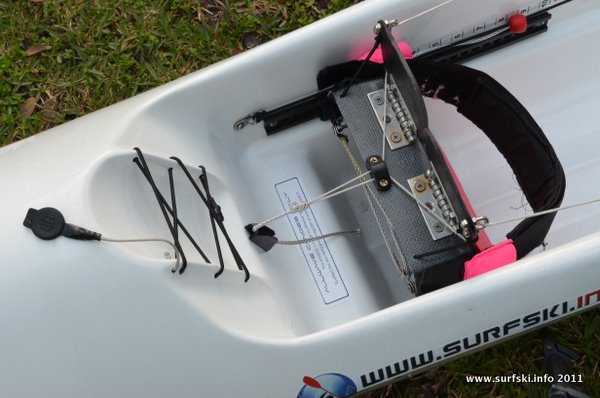
Footplate and pedal angle controls - well engineered but too fiddly?
Cockpit
I found the cockpit very comfortable; one of the more comfortable skis I’ve tried. I’m one of the few people who can’t paddle the Epic skis without a bum pad (my coccyx rubs raw) and I find Fenns most comfortable. So if you’re compatible with a Fenn bucket, you’ll fit this one too. One caveat though: this is a narrow ski and several of the folks who tried it found it a very snug fit.
Emergency steering gear
Honcho were the first (that I saw) to install a “get me home” emergency steering system on a ski. The idea behind this is that if you break a rudder line, you can hook a strong elastic cord to the tiller bar on the same side as the unbroken line. The rudder is now tensioned and automatically steers toward the side of the broken line – but you can steer with the pedal whose line is still attached.
(Honcho have since gone out of business; some of the moulds were taken on by Knysna Racing Kayaks in South Africa.)
Allwave have a superb implementation of this idea; I tested it and it works perfectly. With the bungi attached, the rudder has a strong enough tendency to turn to one side, that the ski is controllable even when moving fast downwind. When not in use, the bungi is hooked to the cover that extends over the tiller bar. Very neat.
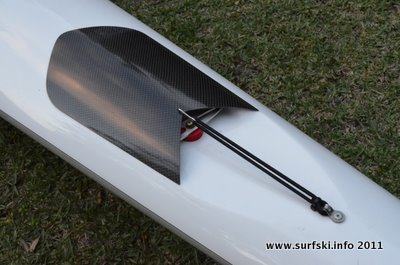
The emergency rudder steering system - hooked out of the way
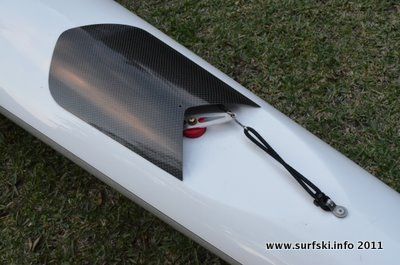
The left hand rudder line has snapped; the emergency steering system is now hooked to the right hand end of the tiller bar. Steering is now possible using the right hand rudder pedal only.
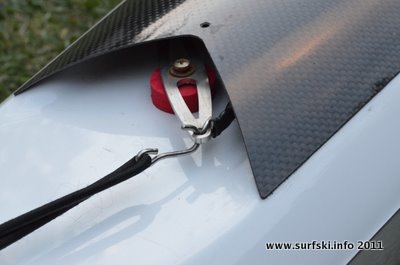
The bungi has a blunt stainless steel hook on the end - hooked here onto the tiller bar
This impressed me sufficiently that I’m going to modify my skis to have a similar system. I’ve seen many paddlers break rudder lines – and at least five I can remember happened in big downwind conditions with extreme discomfort resulting.
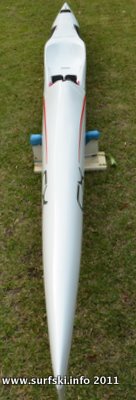
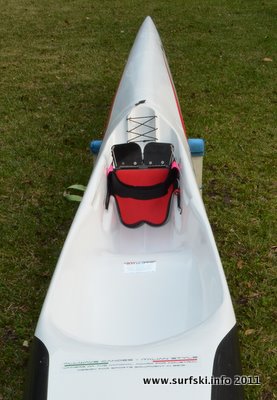
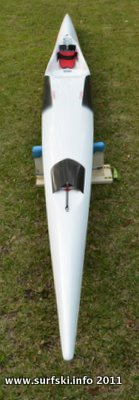
Paddling the CX
Ok, so enough of the wonderful engineering of the ski. What’s it like to paddle?
Flat water
We did a number of flat-water sprints inside Hout Bay Harbor. My impression is that the ski is no slower than the other high-end skis. I also had an elite paddler try it in flat conditions with his training group and he too said that he was impressed with the way the boat performed.
Nauticat Test – Broaching
I hate a ski that broaches too easily (and although broaching seems to be something that doesn’t really happen to elite paddlers, it’s the bane of us mid-packers going downwind). The old Fenn Mako6 was a case in point – in the kind of downwind conditions prevalent here in Cape Town (steep wind generated swell), the Mako6 would broach at the drop of a hat – making for frustrating and irritating paddling. (A larger elliptical surf rudder completely changes this characteristic of the Mako6, and I can strongly recommend the conversion to anyone still paddling the ‘6.)
There’s an 88 ton catamaran tourist boat that operates out of Hout Bay Harbor. Every hour she sets off towards Duiker (aka Seal) Island about 4km away, leaving a superb wake behind her. When the weather’s not suitable for downwind paddling, we like to ride Nauticat’s wake, picking it up at the harbor mouth and staying on it until the boat reaches the island. We tool about in the channel until the tourists have had their fill of the Seals, then we hop back onto her wake and ride it back to the harbor.
Apart from the fun, it’s a great exercise in catching small runs. (Just lately the captain has increased the average speed to nearly 15kph, which makes it even more challenging to stay on the wave.)
But it’s also a great test of the tendency of a ski to broach. The waves streaming out behind the boat are short and steep, and if a ski is prone to broaching, it’s almost impossible to handle. You feel the ski slewing out of control; you veer sideways and by the time you’ve turned the ski back on course you’re one wave further back.
The Allwave CX handles the Nauticat Test with aplomb – it was easy to stay on the wave and I could steer backwards and forwards moving out and then back in along the wave. Phenomenal handling that bode well for downwind paddling.
Choppy water and messy downwind
Having ridden Nauticat’s wake back from the island, we met a friend at the entrance to the harbor and set off again back across the bay. A light southeaster was blowing and the water, as always in Hout Bay, was choppy. Heading directly into the wind, I found the ski a blast; I was able to put my head down and drop my companions at will.
At the base of Chapman’s Peak we turned around to set off downwind back to the harbor. Now however I found that I felt quite unstable in the ski and, instead picking up the runs in the slop as normal, I battled to find a rhythm and my buddies dropped me. I’m still not sure quite why I found the ski difficult to handle in these conditions – but it happened again during a messy Millers Run, described below.
Downwind paddling
I did several Millers Runs in the ski – two classic runs in southeasters, and a Reverse Millers in a northwester.
Millers #1
Conditions: 2-3ft waves, 15-20kt Southeaster (20-22kt registering at the half-way point, Roman Rock).
I found the ski quite twitchy, but found that the faster I went, the more secure I felt. The ski accelerated very easily onto the runs and was exceptionally easy to maneuver. With never a hint of a broach, I was touching the rudder to turn the ski to chase the next dip.
Although the nose of the ski seems to be quite low in volume, it didn’t seem to nosedive and although some water came in over the cockpit sides, it drained very quickly through the bullet-equipped bailers.
Easy Remount
Approaching Fish Hoek Bay, I hooked the paddle on a wave and in the blink of an eye I flipped into the water. I was back in the ski and paddling inside 30 seconds, which is pretty fast for me. The ski is easy to remount!
And I beat my buddies handily in spite of falling in. So far so good.
Reverse Millers
When the northwester blows, we go with it, offshore from Fish Hoek to Millers Point. When the wind is strong, the runs start at the mouth of the bay, but usually they only start half way to the lighthouse, growing in size steadily.
In contrast to the Millers Run the waves are usually regular and clean – purely wind generated chop.
What fascinated me was the way I could paddle the runs diagonally – 20-30 degrees either direction, again, without a hint of a broach.
In these conditions, the ski is a joy to paddle.
Millers #2
Conditions: 3-4ft waves, 25kt SE.
The first 800m of the run is often quite challenging, since you’re paddling diagonally out into the wind and swell to get to Bakoven Rock – which marks the beginning of the downwind section to Fish Hoek.
In the side-wind and waves I found the ski twitchier than my regular steed (the Fenn Mako Elite). I’d like to try the ski with a slightly de-tuned rudder. The rudder is very effective and well balanced and perhaps a rudder with less bite would improve the stability.
The run itself went very well – the ski’s maneuverability was again striking.
In the bigger runs I never nosedived and although the cockpit did flood once or twice over the rails, I noted that (perhaps because the volume of the cockpit itself is relatively small) even with the weight of the water, the handling didn’t deteriorate markedly. (I’ve paddled other skis that were almost unmanageable with a full cockpit, wallowing and continuously nosediving.)
On balance I’ll gladly accept the dampness caused by the low cockpit rails - given how easy the ski is to remount.
Millers #3
Conditions: 2-3ft but messy, confused seas, 20kt SE
My final run in the ski wasn’t so happy. Once again, the waves were small but were ricocheting in all directions – and I couldn’t get settled in the boat. I found it difficult to make ground against my buddies and ended up taking a swim halfway between the lighthouse and Fish Hoek beach.
Swimming
I took a total of three swims while paddling the ski and apart from confirming that it’s an easy remount(!) I suspect that the secondary stability may be a little less than the Fenn Mako Elite – making it a slightly less forgiving ski.
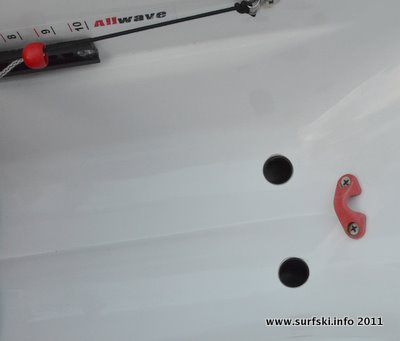
I like: the footplate measurement tape; the position of the scuppers; the leash anchor point
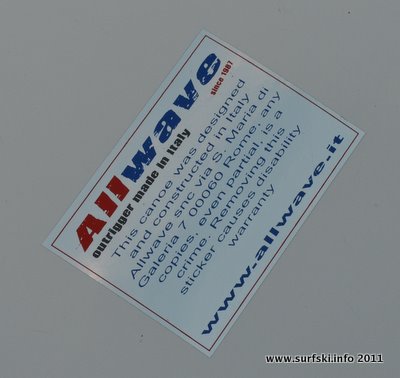
I like: the "don't copy" warning notice!
What I like
- The Aesthetics – Italians sure know how to design style into a boat!
- The superb quality of the build
- The weight
- The comfort of the cockpit
- The footplate adjustment control
- The shape of the footplate (longer than normal)
- The steering
- The acceleration and handling on clean downwind runs
- The lack of propensity to broach
- The speed on flat/choppy water
- The emergency steering setup
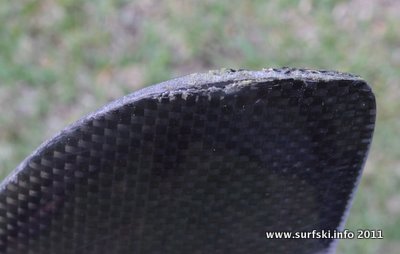
I don't like: the flimsy rudder - it needs to be beefed up so that incidental knocks on the ground or even rocks don't damage it like this
What I don’t like
- I found the ski a little more twitchy than my Mako Elite.
- I didn’t perform well going downwind in small confused seas.
- A couple of the folks who tried it said they found the bucket too narrow.
- The name… Surely there’s a sexier/more exotic/more elegant name out there than “Allwave CX”! The ski deserves it!
In Summary
This is one of the most exciting new skis I’ve ever paddled. It’s clearly for advanced paddlers – but it seems fast and catches runs with alacrity. I’d like to see a version slightly wider (and less tippy).
In my opinion, this ski ranks up there with the rest of the “elite” level skis… If you can get your hands on one, definitely include it in your list of skis to try out.
In particular women and men of lighter build may find this a particularly agreeable ski – it’s light, has low volume and a narrow cockpit.

